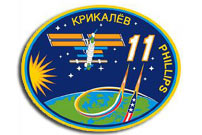NASA Space Station On-Orbit Status 29 May 2005

SpaceRef note: This NASA Headquarters internal status report, as presented here, contains additional, original material produced by SpaceRef.com (copyright © 2005) to enhance access to related status reports and NASA activities.
All ISS systems continue to function nominally, except those noted previously or below.
Sunday — off-duty day for Sergei Krikalev and John Phillips, except for some housekeeping and voluntary work.
As part of regular morning inspection after wakeup, CDR Krikalev checked up on a fluid connector of the ASU urine collection system in the Service Module (SM) behind panel 139.
Sergei also completed the daily routine maintenance of the SM’s SOZh environment control & life support system, today including the regular inspection of the BRPK air/liquid condensate separator apparatus and the weekly collection of the toilet flush (SP) counter and water supply (SVO) readings for calldown to TsUP/Moscow.
|
Shuttle |
At his discretion for today, Krikalev had three tasks from the “job jar” work list. He first replaced the batteries of the BTKh-12 “Bioecology” experiment’s ART (automatic temperature recorder) in the forward endcone of the SM work area (RO), performed a visual inspection of the hardware and took photographs of the installation for documentation, [The battery-driven BTKh-12 studies the effects of cosmic rays, instantaneous radiation and flows of heavier charged particles on microbiological objects used in the Russian national economy, attempting to get high-performance strains of microorganisms to manufacture petroleum biodegradants, means of plant protection, and exopolysaccharide used in the oil industry.]
Also off the voluntary task list, Sergei conducted another session with the “Uragan” (hurricane) earth-imaging program, focusing the Nikon D1X No. 3 digital camera with 800-mm lens on targets called out on an uplinked list. [Today’s targets included the mountainous area west of Lake Sevan, the Chirkey Reservoir west of the city of Makhachkala on the Dagestan Plain, detailed imagery of the Mangyshlak Peninsula, the Katun River valley, banks of Lake Teletskoye, panoramic views of the Altai and Sayan Mountains, the cities of Vladivostok and Minsk, villages along the Don River, the Volga floodplain, suburbs of Astrakhan, the city of Guriev on the Ural River, panoramic views of the Crimean and the Caucasus from Taman to Ajaria, and panoramas of mountains in Iran to the S of the Caspian Sea.]
As a third “job jar” suggestion, the CDR conducted his third run of the “Diatomeya” ocean observations program, using the DSR PD-150P video camera on SM window #8 and Nikon F5 digital still camera with 24/85-mm lens from window #7 to obtain data characterizing the impacts of river influxes, sea-floor relief, hydrodynamic and atmospheric phenomena on bio-production processes during the end of May, [Today’s observations focused on the North Atlantic – the waters off Newfoundland and the Gulf Stream.]
Both crewmembers conducted their regular 2.5-hr. physical exercise program on the TVIS treadmill, RED resistive machine and VELO bike with bungee cord load trainer, [Sergei’s daily protocol prescribes a strict four-day microcycle exercise with 1.5 hr on the treadmill and one hour on VELO plus load trainer (today: Day 2 of a new set).]
No CEO (crew earth observations) photo targets today.
CEO photography can be viewed and studied at the websites:
- http://eol.jsc.nasa.gov
- http://earthobservatory.nasa.gov
- http://earthobservatory.nasa.gov/Study/AstronautPhotography/
See also the website “Space Station Challenge” at:
To view the latest photos taken by the expedition 11 crew visit:
- http://spaceflight.nasa.gov/gallery/images/station/crew-11/ndxpage1.html at NASA’s Human Spaceflight website.
Expedition 11 Flight Crew Plans can be found at http://spaceflight.nasa.gov/station/timelines/
Previous NASA ISS On-orbit Status Reports can be found here. Previous NASA Space Station Status Reports can be found here. Previous NASA Space Shuttle Processing Status Reports can be found here. A collection of all of these reports and other materials relating to Return to Flight for the Space Shuttle fleet can be found here.
|
|
ISS Orbit (as of this noon, 12:31pm EDT [= epoch]):
- Mean altitude — 352.6 km
- Apogee height — 356.4 km
- Perigee height — 348.8 km
- Period — 91.59 min.
- Inclination (to Equator) — 51.65 deg
- Eccentricity — 0.0005677
- Solar Beta Angle — -26.5 deg (magnitude increasing)
- Orbits per 24-hr. day — 15.72
- Mean altitude loss in last 24 hours — 70 m
- Revolutions since FGB/Zarya launch (Nov. 98) — 37277
Some Increment 11 Main Events (not final):
- Progress M-52 (17P) undock — 6/15 (4:13pm EDT);
- Progress M-53 (18P) launch — 6/16 (7:09pm EDT, Baikonur: 6/17, 5:09am)
- Progress M-53 (18P) dock — 6/18 (8:46pm EDT);
- Reboost — ~6/22 (delta-V 1.5 m/s);
- LF-1/STS-114 launch — 7/13 (18-day window opens);
- Soyuz TMA-6 (10S) relocate (from DC-1 to FGB) — ~8/16;
- ULF1.1/STS-121 launch — NET 9/9 (launch window opens);
- 12A/STS-115 launch — NET 2/16/06;
- 12A.1/STS-116 launch — NET 4/23/06;
- 13A/STS-117 launch — NET 5/18/06.
ISS Altitude History
Apogee height — Mean Altitude — Perigee height

For more on ISS orbit and worldwide ISS naked-eye visibility dates/times, see http://www.hq.nasa.gov/osf/station/viewing/issvis.html. In addition, information on International Space Station sighting opportunities can be found at http://spaceflight.nasa.gov/realdata/sightings/ on NASA’s Human Spaceflight website. The current location of the International Space Station can be found at http://science.nasa.gov/temp/StationLoc.html at NASA’s Marshall Space Flight Center. Additional satellite tracking resources can be found at http://www.spaceref.com/iss/tracking.html.









